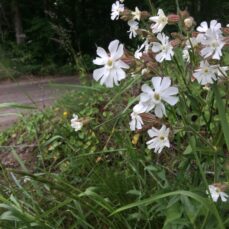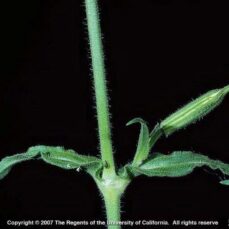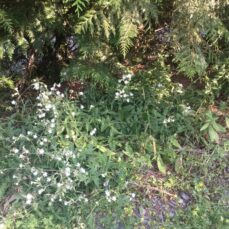
ID Characteristics
General: Night-flowering catchfly is an annual.
Flowers: Petals are showy, creamy white to pinkish and flare out in a circle. Each flower is 1 – 3 cm wide and has 5 deeply lobed petals. As the name indicates, the flowers open at nighttime.
Stems: Are straight, with many branches towards the top of the plant. Night-flowering catchfly can grow to be 0.2 – 1 m tall. Stems have swollen nodes and are covered in sticky hairs.
Leaves: Are opposite and tapering at both ends, with the lower leaves being wider near the tip of the leaf and the middle leaves being widest near the stem. They are approximately 5 – 12 cm long by 4 cm wide and covered in sticky hairs.
Fruit: The seeds are small, greyish-orange, kidney-shaped and rough. The seeds are enclosed in a small, brown and bumpy capsule (about 1 mm long)
Roots: Night-flowering catchfly has a thin, finely-branched taproot.
Similar Species
Invasive
Bladder campion (Silene vulgaris): its seeds are more grey than night-flowering catchfly’s.

Bladder Campion (Silene vulgaris) Chris Evans, University of Illinois, Bugwood.org
Native
Many Silene plants are native to BC, and several are rare. However, all native Silene are perennial and none have the stickiness of night-flowering catchfly.

Native Moss Campion (Silene acaulis) by Mary Ellen (Mel) Harte, Bugwood.org
Habitat and Origin
Night-flowering catchfly is native to Europe.
Night-flowering catchfly is common in cultivated fields, pastures, along railways, roadsides, and in disturbed areas. It thrives in sandy and gravelly soils and requires high summer temperatures (20°C and above) for germination.
How It Spreads
Night-flowering catchfly is an annual plant that reproduces by seed. One plant can produce up to 2500 seeds which are generally pollinated by moths. However, the plants can also self-pollinate, especially in contained areas (like greenhouses). Seeds are viable immediately after production and remain viable in the soil for over 3 years.
Most night-flowering catchfly seeds fall to the ground close to the parent plant. However, night-flowering catchfly may also be spread in contaminated seed, since its seeds are very small and difficult to separate from clover seeds. When ingested, seeds survive the passage through the digestive system of livestock, contributing to the plant’s spread.
Impacts
Ecological:
- Outcompetes native species, reducing biodiversity.
- Its prolific seed production allows it to colonize disturbed sites rapidly.
- Unpalatable to livestock.
Economic:
- Infests grain fields, legume crops, and pastures and can pose problems in gardens and horticultural nurseries.
- Contaminates clover and forage seed, making the seeds or forage difficult to clean.
Prevent the Spread
There is insufficient information about night-flowering catchfly’s distribution, impacts, potential for spread and feasibility for control in the Sea to Sky. If you see night-flowering catchfly, please report it.
Learn to identify night-flowering catchfly: use the images presented in this profile page to learn how to identify night-flowering catchfly.
What to do if you spot it: You can report any night-flowering catchfly sighting by visiting our reporting page.
DO:
- Regularly monitor properties for weed infestations.
- Ensure soil and gravel are uncontaminated before transport.
- Check wildflower mixes to ensure that they do not contain night-flowering catchfly.
- Ensure plants are disposed of in a garbage bag if found in floral arrangements to prevent seeds from spreading.
DO NOT:
- Do not unload, park or store equipment or vehicles in infested areas; remove plant material from any equipment, vehicles, or clothing used in such areas and wash equipment and vehicles at designated cleaning sites before leaving infested areas.
- Do not plant night-flowering catchfly in a garden, no matter how well-contained its enclosure may seem.
- Do not move soil that has been contaminated with night-flowering catchfly.
- Do not compost night-flowering catchfly.
Control
Mechanical control:
Shallow cultivation can help reduce the plant’s density. In Britain, burning and early tillage are also used to decrease population density. The main objective of mechanical control is to prevent seed production since night-flowering catchfly is an annual.
Chemical control:
There are limited herbicide options available for chemical control of this species.
We recommend that any herbicide application is carried out by a person holding a valid BC Pesticide Applicator Certificate. Before selecting and applying herbicides, you must review and follow herbicide labels and application rates; municipal, regional, provincial and federal laws and regulations; species-specific treatment recommendations, and site-specific goals and objectives.
Biological control:
There is no biological control agent available for this plant.
Sea to Sky Distribution
Night-Flowering Catchfly Factsheet
Having trouble viewing the factsheet? Don’t worry, all the information is included on this page. You can also contact us with any questions.
References
- Alaska Center for Conservation Science, Night-Flowering Catchfly
- Canadian Food Inspection Agency, Weed Seed: Silene noctiflora (Night-flowering catchfly)
- Canadian Science Publishing, The Biology of Canadian Weeds
- Electronic Atlas of the Flora of BC, Silene noctiflora
- Farms.com, Night-Flowering Catchfly
- Government of BC, Field Guide to Noxious Weeds and Other Selected Plants of British Columbia
- Government of Manitoba, Night-Flowering Catchfly
- Government of Ontario, Night-Flowering Catchfly
- Grainews, Identifying those tough to ID weeds
- NatureGate, Night-Flowering Catchfly
- NatureSpot, Night-Flowering Catchfly
- Ontario Wildflowers, Night-Flowering Catchfly
- Peace River Regional District, Night-Flowering Catchfly
- Phoenix Amenity Supplies, Night-Flowering Catchfly












